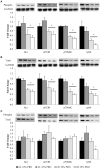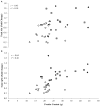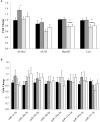Prolonged Calorie Restriction Downregulates Skeletal Muscle mTORC1 Signaling Independent of Dietary Protein Intake and Associated microRNA Expression
- PMID: 27761114
- PMCID: PMC5050214
- DOI: 10.3389/fphys.2016.00445
Prolonged Calorie Restriction Downregulates Skeletal Muscle mTORC1 Signaling Independent of Dietary Protein Intake and Associated microRNA Expression
Abstract
Short-term (5-10 days) calorie restriction (CR) downregulates muscle protein synthesis, with consumption of a high protein-based diet attenuating this decline. Benefit of increase protein intake is believed to be due to maintenance of amino acid-mediated anabolic signaling through the mechanistic target of rapamycin complex 1 (mTORC1), however, there is limited evidence to support this contention. The purpose of this investigation was to determine the effects of prolonged CR and high protein diets on skeletal muscle mTORC1 signaling and expression of associated microRNA (miR). Twelve-week old male Sprague Dawley rats consumed ad libitum (AL) or calorie restricted (CR; 40%) adequate (10%, AIN-93M) or high (32%) protein milk-based diets for 16 weeks. Body composition was determined using dual energy X-ray absorptiometry and muscle protein content was calculated from muscle homogenate protein concentrations expressed relative to fat-free mass to estimate protein content. Western blot and RT-qPCR were used to determine mTORC1 signaling and mRNA and miR expression in fasted mixed gastrocnemius. Independent of dietary protein intake, muscle protein content was 38% lower (P < 0.05) in CR compared to AL. Phosphorylation and total Akt, mTOR, rpS6, and p70S6K were lower (P < 0.05) in CR vs. AL, and total rpS6 was associated with muscle protein content (r = 0.64, r2 = 0.36). Skeletal muscle miR expression was not altered by either energy or protein intake. This study provides evidence that chronic CR attenuates muscle protein content by downregulating mTORC1 signaling. This response is independent of skeletal muscle miR and dietary protein.
Keywords: energy deficit; miR-100; miR-99; muscle protein content; rpS6.
Figures

 ), n = 10 (AL 32% PRO;
), n = 10 (AL 32% PRO;  ), n = 10 (CR 10% PRO;
), n = 10 (CR 10% PRO;  ), n = 10 (CR 32% PRO; □)] body mass (A), fat mass (B), fat-free mass (C), and muscle protein content (D). Data analyzed using a univariate ANOVA with Bonferroni correction to determine main effects of energy (AL vs. CR), protein (10 vs. 32%) and energy-by-time interactions. †Week 16 different from Baseline; P < 0.05. +Time-by-energy interaction, CR different from AL at week 16; P < 0.05. *CR different from AL; P < 0.05.
), n = 10 (CR 32% PRO; □)] body mass (A), fat mass (B), fat-free mass (C), and muscle protein content (D). Data analyzed using a univariate ANOVA with Bonferroni correction to determine main effects of energy (AL vs. CR), protein (10 vs. 32%) and energy-by-time interactions. †Week 16 different from Baseline; P < 0.05. +Time-by-energy interaction, CR different from AL at week 16; P < 0.05. *CR different from AL; P < 0.05.

 ), n = 10 (CR 10% PRO
), n = 10 (CR 10% PRO  ), n = 10 (CR 32% PRO ◦)]. Data analyzed using a spearman rho correlation coefficient. Significant associations were determined as P < 0.05.
), n = 10 (CR 32% PRO ◦)]. Data analyzed using a spearman rho correlation coefficient. Significant associations were determined as P < 0.05.
 ), n = 10 (AL 32% PRO;
), n = 10 (AL 32% PRO;  ), n = 10 (CR 10% PRO;
), n = 10 (CR 10% PRO;  ), n = 10 (CR 32% PRO; □)] mRNA (A) and miR (B) expression. Data analyzed using a univariate ANOVA with Bonferroni correction to determine main effects of energy (AL vs. CR), protein (10 vs. 32%) and energy-by-protein interactions. *CR body mass different from AL; P < 0.05. +32% PRO different than 10%; P < 0.05.
), n = 10 (CR 32% PRO; □)] mRNA (A) and miR (B) expression. Data analyzed using a univariate ANOVA with Bonferroni correction to determine main effects of energy (AL vs. CR), protein (10 vs. 32%) and energy-by-protein interactions. *CR body mass different from AL; P < 0.05. +32% PRO different than 10%; P < 0.05.
 ), n = 10 (AL 32% PRO;
), n = 10 (AL 32% PRO;  ), n = 10 (CR 10% PRO;
), n = 10 (CR 10% PRO;  ), n = 10 (CR 32% PRO; □)] mRNA (A) and mean (± SEM) total AMPKα and PGC-1α (B) expression and citrate synthase activity (C). Data analyzed using a univariate ANOVA with Bonferroni correction to determine main effects of energy (AL vs. CR), protein (10 vs. 32%) and energy-by-protein interactions. *CR different from AL; P < 0.05.
), n = 10 (CR 32% PRO; □)] mRNA (A) and mean (± SEM) total AMPKα and PGC-1α (B) expression and citrate synthase activity (C). Data analyzed using a univariate ANOVA with Bonferroni correction to determine main effects of energy (AL vs. CR), protein (10 vs. 32%) and energy-by-protein interactions. *CR different from AL; P < 0.05.Similar articles
-
Dietary Aronia melanocarpa extract enhances mTORC1 signaling, but has no effect on protein synthesis and protein breakdown-related signaling, in response to resistance exercise in rat skeletal muscle.J Int Soc Sports Nutr. 2019 Dec 11;16(1):60. doi: 10.1186/s12970-019-0328-1. J Int Soc Sports Nutr. 2019. PMID: 31829236 Free PMC article.
-
Calorie Restricted High Protein Diets Downregulate Lipogenesis and Lower Intrahepatic Triglyceride Concentrations in Male Rats.Nutrients. 2016 Sep 15;8(9):571. doi: 10.3390/nu8090571. Nutrients. 2016. PMID: 27649241 Free PMC article.
-
The role of the mechanistic target of rapamycin complex 1 in the regulation of mitochondrial adaptation during skeletal muscle atrophy under denervation or calorie restriction in mice.Appl Physiol Nutr Metab. 2023 Mar 1;48(3):241-255. doi: 10.1139/apnm-2022-0336. Epub 2023 Feb 14. Appl Physiol Nutr Metab. 2023. PMID: 36786420
-
Combined effects of resistance training and calorie restriction on mitochondrial fusion and fission proteins in rat skeletal muscle.J Appl Physiol (1985). 2016 Sep 1;121(3):806-810. doi: 10.1152/japplphysiol.00465.2016. Epub 2016 Aug 18. J Appl Physiol (1985). 2016. PMID: 27539498
-
A Review of the Impact of Calorie Restriction on Stem Cell Potency.Malays J Med Sci. 2021 Aug;28(4):5-13. doi: 10.21315/mjms2021.28.4.2. Epub 2021 Aug 26. Malays J Med Sci. 2021. PMID: 34512126 Free PMC article. Review.
Cited by
-
Recent Advances in the Characterization of Skeletal Muscle and Whole-Body Protein Responses to Dietary Protein and Exercise during Negative Energy Balance.Adv Nutr. 2019 Jan 1;10(1):70-79. doi: 10.1093/advances/nmy087. Adv Nutr. 2019. PMID: 30596808 Free PMC article.
-
Genes interconnecting AMPK and TREM-1 and associated microRNAs in rotator cuff tendon injury.Mol Cell Biochem. 2019 Apr;454(1-2):97-109. doi: 10.1007/s11010-018-3456-z. Epub 2018 Oct 10. Mol Cell Biochem. 2019. PMID: 30306456 Free PMC article.
-
Distinct and additive effects of calorie restriction and rapamycin in aging skeletal muscle.Nat Commun. 2022 Apr 19;13(1):2025. doi: 10.1038/s41467-022-29714-6. Nat Commun. 2022. PMID: 35440545 Free PMC article.
-
Is Rapamycin a Dietary Restriction Mimetic?J Gerontol A Biol Sci Med Sci. 2020 Jan 1;75(1):4-13. doi: 10.1093/gerona/glz060. J Gerontol A Biol Sci Med Sci. 2020. PMID: 30854544 Free PMC article. Review.
-
Effects of a ketogenic diet on body composition and strength in trained women.J Int Soc Sports Nutr. 2020 Apr 10;17(1):19. doi: 10.1186/s12970-020-00348-7. J Int Soc Sports Nutr. 2020. PMID: 32276630 Free PMC article. Clinical Trial.
References
-
- Areta J. L., Burke L. M., Camera D. M., West D. W., Crawshay S., Moore D. R., et al. . (2014). Reduced resting skeletal muscle protein synthesis is rescued by resistance exercise and protein ingestion following short-term energy deficit. Am. J. Physiol. Endocrinol. Metab. 306, E989–E997. 10.1152/ajpendo.00590.2013 - DOI - PubMed
-
- Churchward-Venne T. A., Breen L., Di Donato D. M., Hector A. J., Mitchell C. J., Moore D. R., et al. . (2014). Leucine supplementation of a low-protein mixed macronutrient beverage enhances myofibrillar protein synthesis in young men: a double-blind, randomized trial. Am. J. Clin. Nutr. 99, 276–286. 10.3945/ajcn.113.068775 - DOI - PubMed
-
- Drummond M. J., Glynn E. L., Fry C. S., Timmerman K. L., Volpi E., Rasmussen B. B. (2010). An increase in essential amino acid availability upregulates amino acid transporter expression in human skeletal muscle. Am. J. Physiol. Endocrinol. Metab. 298, E1011–E1018. 10.1152/ajpendo.00690.2009 - DOI - PMC - PubMed
Grants and funding
LinkOut - more resources
Full Text Sources
Other Literature Sources
Miscellaneous

